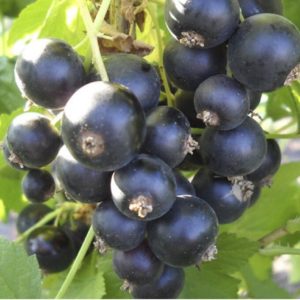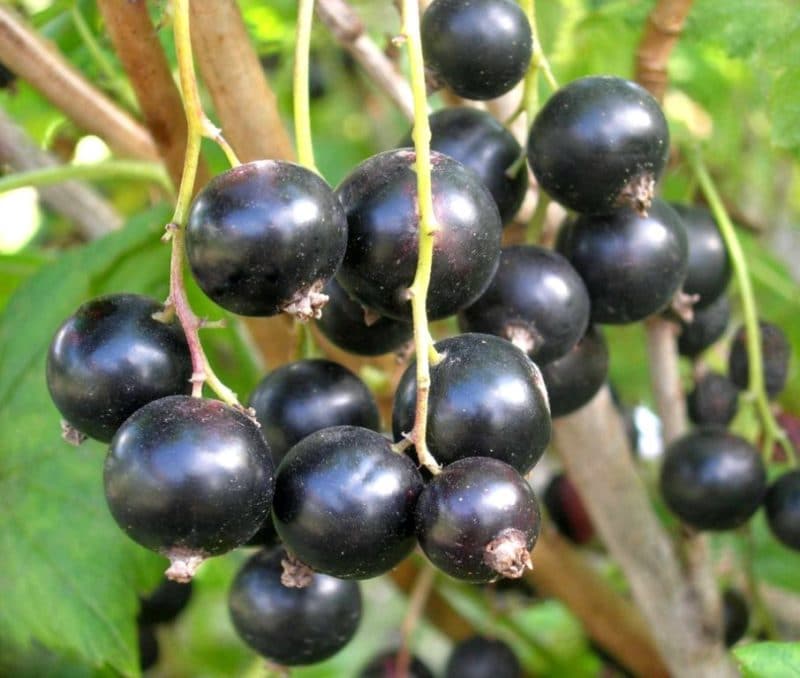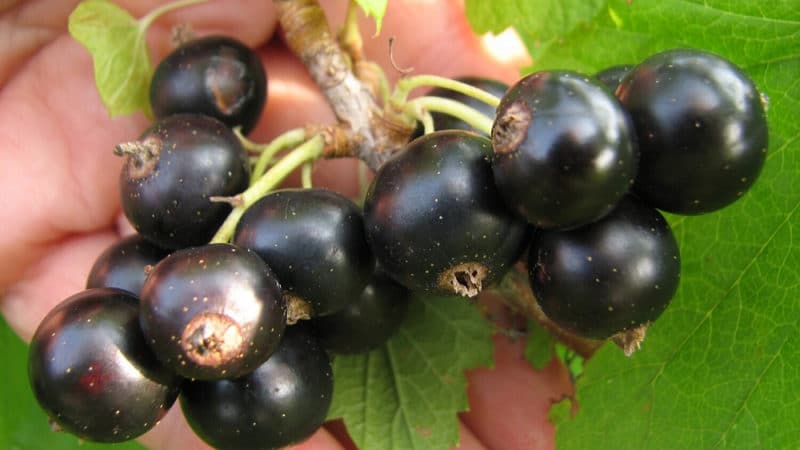Why is it worth planting the Pygmy blackcurrant variety and how to grow it
Black currant Pygmy is a favorite variety of many gardeners. It is characterized by high yield, drought resistance, frost resistance, immunity to powdery mildew and anthracnose, dessert taste of berries and rich aroma. The self-fertile variety does not require additional pollination, but joint planting with other varieties of the crop significantly increases its productivity. In this article we will talk about the features of planting and caring for the Pygmy variety.
Black currant Pygmy: description of the variety
Blackcurrant Pygmy was bred by V. S. Ilyin, a breeder at the South Ural Research Institute of Horticulture and Potato Growing. When creating the variety, Bredthorpe and Seedling Golubki were used. In 1999, Pygmy was included in the State Register and received permission to grow in the Volga-Vyatka, Ural, Western and Eastern regions.Siberian, Far Eastern regions.
The bushes are medium-sized, slightly spreading, with average foliage. The shoots are straight, of moderate thickness, colored light green with a slight anthocyanin tint. The buds are medium-sized, single, oval, brown, tightly adjacent to the shoot or extending from it at an angle of 30°. The leaf scar is cone-shaped.
The leaf blade is five-lobed, large, green, wrinkled, shiny, slightly concave along the midrib. The blades are pointed, the lateral ones are smaller than the central one, wide, sharp tips are directed to the sides. The basal lobes are pronounced. The base of the leaf has a deep rounded or triangular notch.The teeth are wide and pointed. The petiole is long, of medium thickness, light green with a pink undertone, pubescent.
The flowers are medium-sized, saucer-shaped. The sepals are wide, the upper part is painted pale pink or yellow-pink. The clusters are of moderate length, each ripening with 5-10 berries.
The fruits are large, weighing 2.3-7.7 g, round in shape, with thin black skin. The pulp is sweet, with an average number of seeds. The taste is dessert. Tasting score - 5 points.
Flowering lasts 40-45 days. The berries ripen in early July. The fruiting period is 1-1.5 months.
Environmental resistance, yield and application
The Pygmy variety is characterized by high winter hardiness and resistance to powdery mildew and anthracnose. Tolerates sudden changes in average daily temperature.
On average, 3.5-6.4 kg is collected from one bush. Maximum yield is 1.6-5.7 kg per bush.
Blackcurrant berries are consumed fresh; compotes, preserves, jam, jelly, wine, sauces, and tinctures are prepared. When frozen and dried, the fruits do not lose beneficial features. Stores in the refrigerator for up to 1 month. Transportability is high.
Advantages and disadvantages

Advantages of the Pygmy variety:
- large berries;
- self-fertility;
- drought resistance;
- frost resistance;
- dessert taste;
- high productivity;
- immunity to powdery mildew and anthracnose.
Disadvantages: predisposition to septoria and kidney mites.
Growing technology
The Pygmy blackcurrant variety is unpretentious and can grow in any climatic conditions. However, to maintain the health of the plant and obtain a good harvest, you need to adhere to a number of rules for planting and care.
Growing conditions are the same for all regions, except that in areas with harsh winters the bushes must be covered.
Currants love sunny areas, protected from drafts. The southwestern part of the garden with light, slightly acidic soil and groundwater depth no higher than 1.5 m is ideal for planting.
Landing dates and rules
Planting of seedlings is carried out during the period when the root system is most active. At soil temperatures below +3°C and above +25°C, roots slow down, so the optimal time for planting is April - May or September - October. Experienced gardeners advise planting currants in the fall. By spring, the bush will have time to take root in a new place and will quickly grow as the weather warms up.
Suitable for planting are annual seedlings up to 40 cm in height, without leaves or damage. The roots should be strong, flexible and healthy. If the root system is weathered and dried out, the seedling is placed in water for 2-3 days.
Reference. The Pygmy blackcurrant bush reaches 2 m in height, so when planting you need to maintain a distance of 1.5-2 m. This will ensure an influx of fresh air and sunlight.
Landing algorithm:
- The land is plowed, weeds and debris are removed.
- A hole 40 cm deep and 60 cm wide is dug in the area.
- Part of the soil is mixed with 10 liters of compost, 200 g of superphosphate and 50 g of potassium sulfate and poured into the hole.
- Before planting, the roots are dipped in a mixture of clay and water to retain moisture inside the shoots.
- The seedling is placed in a hole vertically or at an angle of 45° for better shoot growth next season.
- The hole is filled to the top with fertile soil, deepening the root collar by 8-10 cm.
- The branches are cut so that 2-3 developed buds remain. This will ensure the plant has better branching in the future.
- A hole with a diameter of 40 cm is formed around the seedling and watered with water. The norm is 7-8 liters per 1 bush.
- The tree trunk circle is mulched with compost or sawdust.
Further care
The tree trunk circle must be constantly loosened to ensure the flow of moisture and air to the root system. When planting, it is advisable to loosen clayey soil with coarse sand. Considering that the roots of black currant are located shallowly, you need to use the hoe carefully. Mulching the soil will help reduce the frequency of weeding and loosening. In addition, mulch saturates the plant with nutrients.
Currants need abundant watering during the formation of ovaries. The best method of moistening the soil is sprinkling. For 1 liter of Nitrafen you need 30-50 liters of water. During drought, the plant is watered abundantly. Autumn water-recharging watering is carried out after fertilizing.
The crop must be fed with nitrogen to gain green mass, active branching and growth of young shoots, potassium and phosphorus to improve fruiting and enhance the taste characteristics of the berries.
The table shows the frequency of fertilizer application.
| View | How much to deposit | When to deposit |
| Organic |
|
Every year in September - October when digging |
| Liquid organics | 1 liter of chicken manure or mullein per 10 liters of water | Every year in the spring before flowering (water the tree trunk circle) |
| Nitrogen | 20-30 g of ammonium nitrate per 1 m² | In the 3rd year in the spring after flowering, when the ovaries form during loosening |
| Minerals |
|
In the fall when digging |
For bushes that bear fruit, the fertilizer rate is doubled. With increased acidity, add 400-600 g of lime per 1 m² to the soil.
Pruning is carried out annually.The most favorable time is late autumn. In the spring, before the buds open, cut off the frozen tops and damaged branches.
Reference. Pruning supports blackcurrant fruiting. The bulk of the berries are formed from last year's growth.
After pruning the currants when planting the next year, 6-7 shoots are formed, of which 3-4 of the strongest are left. After removing weak branches, the bush actively grows. In the 3rd year of life, plants leave 2-3 annual and 5-6 biennial shoots. In the 4th year, the crown should consist of 3-4 branches from each previous year.
In the future, 20 branches of all ages are left annually to prevent excessive thickening of the bush.
Possible problems, diseases, pests
Pygmy currants are treated with insecticides and fungicides every year for preventive purposes, despite the fact that the plant is resistant to anthracnose and powdery mildew. Treatment with chemicals should not be carried out during the flowering period, as this has a detrimental effect on beneficial insects.
All treatments are stopped a month before harvest or products made with natural ingredients are used. The most popular preventive remedy is garlic infusion. To prepare it you will need 300 g of fresh garlic and 2 liters of boiling water. The mixture is infused for 2 weeks, filtered and diluted in 10 liters of water. To spray one bush, 500 ml of solution per 10 liters of water is required.
The table presents ways to combat insects, viral and bacterial diseases of currants.
| Disease/pests | Signs | Drugs | Processing period |
| Kidney mite | Gall-like growths, drying out of the buds | 300 g of Nitrafen per 10 liters of water or 100 g of colloidal sulfur per 10 liters | Between the snow melting and the buds opening |
| Gooseberry aphid | Dry leaves, hordes of black insects on the back of the leaf | 30 g of Karbofos per 10 liters of water or 30 g of liquid potassium soap per 1 liter | Until the buds open |
| Ognevka | Damaged and rotten berries | 20 g of Chlorophos per 10 liters of water | Before flowering |
| Powdery mildew | Damaged leaves and berries, whitish coating on shoots and greenery | 2% Nitrafen solution or a mixture of 0.4% soda ash and 0.4% soap (40 g per 10 liters of water) | Spraying with Nitrafen before bud break.
Spraying with soda and soap before and after flowering, then every 14 days. |
| Anthracnose | Brown spots 1 mm in size with small dark bumps | 1% solution of Bordeaux mixture or copper sulfate | Before flowering |
| Septoria
|
Small round spots 2-3 mm in size, first brown and then white with a narrow red-brown border | 1% solution of Bordeaux mixture or copper sulfate | Before flowering |
| Currant terry | Elongated petals are lilac in color, terry, berries are distorted in shape or do not set at all | 300 g of Nitrafen per 10 liters of water or 100 g of colloidal sulfur per 10 liters | After the snow melts |
Wintering
For the winter, the bushes are covered with burlap, spruce branches or spunbond. In regions with harsh winters, additional snow is thrown over the covering material.
Pollinator varieties
Black currant Pygmy has the ability to self-pollinate, but cross-pollination with any other varieties increases productivity.
Reproduction
The Pygmy variety is propagated by cuttings and layering.
- Layers are obtained in the spring: the lower shoots are bent and sprinkled with fertile soil, leaving the tops on the surface. Next they are watered and feed potassium-phosphorus supplements, and in the fall they are separated from the mother bush and transplanted to a permanent place. The tree trunk circle is mulched with dry leaves, sawdust or peat.
- Cuttings are taken in early summer. Young and lignified cuttings up to 15 cm long are suitable for propagation. The bottom of the cutting is cut at an angle, the top is left straight. Next, it is placed in a jar with a solution of “Kornevin”, “Heteroauxin” or “Epin”. Before planting, immerse in a mixture of clay and water. Then the cuttings are planted in the ground, covered with polyethylene, watered from time to time, and mulched in winter. In the spring they are moved to a permanent place.
Tips from experienced gardeners for growing
It is best to plant currants in a group of 2-3 bushes so that the branches do not intertwine. This will provide access to sunlight and fresh air. The plant will bear fruit abundantly and suffer less from fungal infections.
For the full growth and fruiting of a currant bush, it is important to ensure timely watering, loosening the soil, periodic application of fertilizers, as well as pruning dry, diseased and old branches. Organic and mineral fertilizers are recommended to be used together with mulch and embedded in the ground under the bush.
Currants love bright places, so it is best to plant the bushes on the sunny side of the site.
The harvest must be collected on time, otherwise, overripe berries will lose some of their beneficial properties.
It is better to plant bushes on a site with a slight slope to ensure the outflow of excess water.
Currants grow well under the canopy of apple and pear trees, but only if the bushes are planted at a distance of 2 m from the tree.
To increase the yield by 2-3 times, 3 seedlings can be planted in each hole, evenly distributing them around the circumference.
To provide the currant plantation with enough water, it is recommended to use a hose instead of buckets. To calculate the displacement for each bush, lower the hose into a bucket and note how many minutes it takes for it to fill. Let's say the bucket fills up in 2 minutes. One bush needs 5 buckets. This means that the hose should lie under the plant for 10 minutes. It is better to apply a small pressure so that the water is evenly absorbed into the soil.
Reviews from gardeners

Reviews about the Pygmy variety are mostly positive. Summer residents praise it for its ease of care, high yield and dessert taste of large fruits.
Maria, Rossosh: “The Pygmy currant variety is my favorite. We have been growing it in the country for more than 6 years. The harvest is always abundant, regardless of weather conditions. The berries are selected, large, aromatic and very sweet. To make jam, you don’t need to add a lot of sugar; such preparations are stored in the refrigerator until the next season.”
Oleg, Kursk: “I’ve been growing the Pygmy variety for a long time. Caring for bushes is easy. I periodically apply fertilizers and water abundantly during drought. When landing, I followed the rule: the higher, the better. I planted it along the fence at a distance of 2 m so that it would be convenient to harvest.”
Irina, Boguchar: “Black currant Pygmy, in my opinion, is the most successful variety. He is easy to care for, rarely gets sick, and is not attacked by hordes of insects. I carry out timely preventive treatment in early spring, apply organic and mineral fertilizers and mulch the tree trunk, which greatly simplifies caring for the plantation. I water with a hose so I don’t have to rush around with water.”
Conclusion
The black currant variety Pygmy is high-yielding, self-fertile, frost-resistant, and tolerates moisture deficiency without loss.When grown with other varieties in the neighborhood, it gives a higher yield. Maintenance procedures include timely watering, adding organic matter and minerals, sanitary and formative pruning, and prevention of powdery mildew.
Large and aromatic berries have a rich, dessert taste, are suitable for making jam, preserves, marshmallows and marmalade, and can withstand transportation well over long distances.